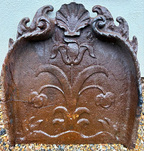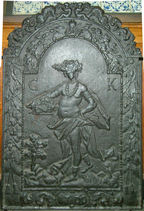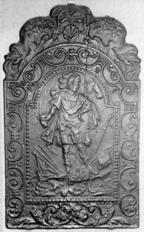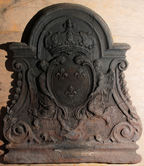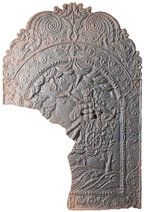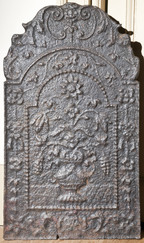-
1321
Description: Arched shape with (damaged) forward-facing 'wings', which splay outwards towards the base, curved to follow the shape of the main panel; central panel with stylised plant decoration surmounted with a scallop shell between six 'leaves'.
Notes: Nothing is known about the sources of free-standing firebacks or what prompted their production. Their form is similar and the predominant use of horticultural or arboreal decorative themes suggests production within a limited time frame. Only a very small number of such castings are known.
- Decoration tags:
- free-standing (shape)
- none (edging)
- whole carved pattern
- plants
Manufactured: in the late-17th to early-18th century in England.
Current location: not known.
- Attached to series:
- Free-standing firebacks
-
83
Description: Arched rectangular shaped central panel, bead-and-pellet edging, semi-naked male figure, wearing a floral head-dress and carrying a basket of produce, initials in top corners; arched rectangular shaped border, fillet edging, symmetrical festoons of foliage, floral scrolls at base, date in an oval cartouche; on top, two putti, two dolphins and scrolled foliage, all symmetrical.
Notes: An allegory of Spring, based closely on an engraving, dated 1600, by Hendrik Goltzius (1558-1617); one of a series of large firebacks of similar date, all bearing the initials, GK.
Copies of this fireback are known.
Inscription: G K / 1700
- Decoration tags:
- 'Dutch' (shape)
- fillet (edging)
- whole carved pattern
- individual letters
- date stamp
- pictorial
- allegorical
- text
- humans
Manufactured: in 1700 possibly in the Siegerland area of Germany.
Current location: Guildford Museum, Guildford, Surrey, England.
Museum number: S,7111 (part of the Guildford Museum museum group)
Citation: Pesch, D., 1982, Herdgussplatten (Rheinland-Verlag, Koln).
- Attached to series:
- 'Dutch' GK series
-
77
Description: 'Dutch' style; arched rectangular shaped central panel, bead edging, two children sitting astride a beast (possibly a winged ram); arched rectangular shaped border, fillet edging, swags of fruit bunches suspended from ribbon; on top, symmetrical floral swirls and flowers.
Notes: The image is probably intended to be Phrixus and Helle riding the winged ram with the golden fleece, but in recasting it has been misinterpreted as the young Samson slaying the lion at Timnath; Judges 14: 5-6.
Copies of this fireback are known.
Inscription: 16 NDW 97 / DER JUNGE SAMSON [the young Samson]
- Decoration tags:
- 'Dutch' (shape)
- fillet (edging)
- whole carved pattern
- individual letters
- individual numbers
- biblical
- monogram
- text
- humans
Manufactured: in the late-17th to early-18th century possibly in the Weald area of England.
Current location: Guildford Museum, Guildford, Surrey, England.
Museum number: G.486 (part of the Guildford Museum museum group)
- Attached to series:
- 'Dutch' NDW series
-
130
Description: Arched rectangular shaped central panel with bead on fillet edging; helmeted figure of Mars holding a cutlass in his right hand, standing on a field of flags, spears and cannon; 'Palladian' shaped border with fillet edging enclosing a repeated scrollwork pattern with floral arrangement at base; on top, symmetrical arrangement of scallop shell between two sea serpents and plant fronds.
Notes: Although in the 'Dutch'; style, an absence of this type in continental collections suggests an British source. Formerly part of the Ade Collection (from Grove Hill, Hellingly, Sussex).
Copies of this fireback are known.
- Decoration tags:
- 'Dutch' (shape)
- fillet (edging)
- whole carved pattern
- mythological
- humans
Manufactured: in the late-17th to early-18th century in England.
Current location: Hastings Museum and Art Gallery, John's Place, Bohemia Road, Hastings, East Sussex, England.
Museum number: HASMG: 1952.51.32 (part of the Hastings Museum museum group)
- Attached to series:
- British 'Dutch' style firebacks
-
139
Description: Arched rectangular shaped central panel with bead-and-pellet edging; figure of Abraham, a scimitar in his raised right hand, which is being restrained by an angel emerging from a cloud; Isaac is kneeling to Abraham's left and a ram is caught in a bush to the left of the plate; the initials are in the top corners; arched rectangular shaped border with fillet edging, and swags of leaves suspended from flowers; on top, symmetrical foliate swirls.
Notes: The design is an adaptation of an engraving by Adriaen Collaert (1555-1623) of a painting by Maarten de Vos (1532-1603), Plate 5 of The Story of Abraham. In the 'Thesaurus sacrarum historiarum veteris testamenti', published in Antwerp by Gerard de Jode (1509-1591) in 1579, 1585 and, subsequently, by Visscher in 1589. One of a small group of firebacks, all of similar shape, some with biblical designs, others mythological, all dated around 1700 and bearing the letters GK. Formerly part of the Ade Collection (from Grove Hill, Hellingly, Sussex).
Copies of this fireback are known.
Inscription: G K / 1700
- Decoration tags:
- 'Dutch' (shape)
- fillet (edging)
- whole carved pattern
- individual letters
- biblical
- text
- humans
Manufactured: in 1700 in the Siegerland area of Germany.
Current location: Hastings Museum and Art Gallery, John's Place, Bohemia Road, Hastings, East Sussex, England.
Museum number: HASMG: 1952.51.37 (part of the Hastings Museum museum group)
Citation: Lloyd, N., 1925, 'Domestic Ironwork I', Architectural Review, 58, pp. 58-67.
- Attached to series:
- 'Dutch' GK series
- Old Testament & Apocrypha firebacks
- Abraham & Isaac firebacks
-
160
Description: Arched rectangular shaped panel with fillet edging; two Salomonic columns supporting a beaded arch; standing figure of Atlas supporting a globe, on ground with plants, and two swags of fruit and leaves suspended from the centre of the arch to the capitals of the columns; above the beaded arch, symmetrical swirls of fruit and foliage; on top, a scallop shell between two sea serpents.
Notes: Probably an English design copying the north German 'Dutch' style.
Copies of this fireback are known.
- Decoration tags:
- 'Dutch' (shape)
- fillet (edging)
- whole carved pattern
- mythological
- architectural
- humans
- plants
- objects
Manufactured: in the late-17th to early-18th century in England.
Current location: Hastings Museum and Art Gallery, John's Place, Bohemia Road, Hastings, East Sussex, England.
Museum number: HASMG: 1917.196.6 (part of the Hastings Museum museum group)
Citation: Butterfield, W. R., 1916, 'Old Wealden Firebacks', The Connoisseur, 46, pp. 197-209.
Citation: Lloyd, N., 1925, 'Domestic Ironwork I', Architectural Review, 58, pp. 58-67.
Citation: Baines, J. M., 1958, Wealden Firebacks (Hastings Museum).
- Attached to series:
- British 'Dutch' style firebacks
-
163
Description: Arched rectangular shape with fillet edging; tall, arched central panel with bead edging (top and sides); flying bird in arch, with two small trees below, and two figures, one with a staff in his right hand, and a dog, at the bottom; two side panels with similar cascades of flowers; narrow base panel with fillet edging and symmetrical floral arrangement; on top, a scallop shell between two symmetrical lines of trailing flowers.
Notes: The figures may be Venus and Adonis, the bird aboive being a dove; probably an English design based on the 'Dutch' style. Formerly part of the Ade Collection (from Grove Hill, Hellingly, Sussex).
Manufactured: in the late-17th to early-18th century in England.
Current location: Hastings Museum and Art Gallery, John's Place, Bohemia Road, Hastings, East Sussex, England.
Museum number: HASMG: 1952.51.31 (part of the Hastings Museum museum group)
- Attached to series:
- British 'Dutch' style firebacks
-
940
Description: Upon a rectangular base plinth, wide scrolled side fillets with foliage about the scrolls and suspended bell flowers in chain above; central oval shield bearing three fleurs-de-lys supported by an angel on each side, and surmounted by a French royal crown; on top, an arch rising from horizontal moulding on each side.
Notes: Characteristic of designs illustrated by architects such as Daniel Marot.
Arms: France Royal
- Decoration tags:
- rectangular with round arch (shape)
- complex individual (edging)
- whole carved pattern
- planklines
- armorial
- royal
Manufactured: in the late-17th to early-18th century in France.
Current location: not known.
- Attached to series:
- Foreign armorial firebacks
-
325
Description: Arched rectangular shaped central panel with bead-and-pellet edging on a broad fillet; Jupiter in his chariot drawn by eagles; above are clouds, below is a landscape; arched rectangular shaped border with fillet edging, with a symmetrical scrolled wire design; the monogram, SHR, bottom centre; above is a symmetrical design of scrolled floral tendrils.
Notes: The design is probably adapted from a personification of the planet, Jupiter, in 'Planetarum effectus et eorum in signis zodiaci', by Marten de Vos (1585). Two editions of engravings of de Vos's drawings are known, by Jan Sadeler, dated 1585, and by Gregor Fentzel in about 1650.
Inscription: SHR
- Decoration tags:
- 'Dutch' (shape)
- fillet (edging)
- whole carved pattern
- pictorial
- mythological
- allegorical
- text
- humans
Manufactured: in the late-17th to early-18th century in England.
Current location: Horsham Museum, Causeway, Horsham, West Sussex, England.
(part of the Horsham Museum museum group)
- Attached to series:
- SHR series
- British 'Dutch' style firebacks
- De Vos Planets series
-
1117
Description: Arched rectangular shaped central panel, bead edging, narrow-necked urn with swagged decoration and gadrooned base, flowers issuing therefrom; arched rectangular shaped border with fillet edging and symmetrical floral festoons; on top, mirrored plant fronds descending from a small mask; at the bottom, an indistinct cartouche and a probable letter 'W' between swirled foliage.
Notes: Small firebacks of this type and period might have been cast at one of the London foundries and used for attaching to the rear of dog grates. The initial 'W' probably denotes the pattern maker.
Inscription: W
Manufactured: in the late-17th to early-18th century possibly in the London area of England.
Current location: in private hands, Isleworth, London, England.
- Attached to series:
- British 'Dutch' style firebacks
- W series
